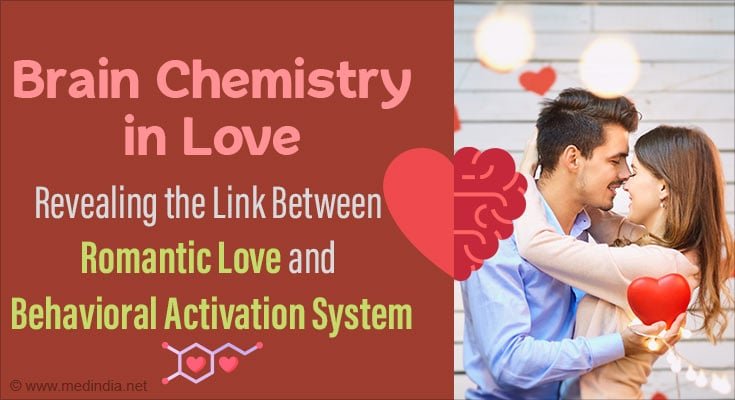What is the Science Behind Romantic Love?

- Romantic love experience is due to a complex interplay of the brain’s Behavioral Activation System(BAS) sensitivity, oxytocin, and dopamine
- The BAS sensitivity is associated with the VTA(ventral tegmental area)–nucleus accumbens pathway in the brain
- The intricate neurochemical dynamics explore facets of romantic love across human evolutionary history
Romantic love is widely recognized for its profound impact on the brain, with the release of oxytocin, commonly known as the “love hormone” or “bonding hormone.” Despite this awareness, unraveling the intricate neural pathways that shape romantic love proves challenging, adding complexity to the research of this dynamic facet of human relationships.
Scientists from the Australian National University (ANU), the University of Canberra, and the University of South Australia have illuminated the mechanisms behind romantic love (1✔ ✔Trusted Source
Romantic Love and Behavioral Activation System Sensitivity to a Loved One
). They quantified the involvement of specific brain regions in the process of idealizing our romantic partners, shedding light on its evolutionary phenomenon.
Advertisement
Unraveling the Neurological Tapestry of Romantic Love
In the first-ever study exploring the connection between the human brain’s Behavioral Activation System (BAS) and romantic love, a survey was conducted on 1556 young adults who self-identified as being “in love.” The study featured questions that delved into participant’s emotional responses to their partners, their behaviors in their presence, and the degree of focus on their loved ones over other aspects of life.
The research assessed BAS sensitivity in the context of romantic love and evaluated the efficacy of empirical studies investigating the interplay between BAS and romantic relationships.
BAS sensitivity has been linked to the activity observed in the VTA (ventral tegmental area)–nucleus accumbens pathway and the orbitofrontal cortex. In healthy individuals, BAS reward responsiveness has been correlated with the lateral prefrontal cortex, anterior cingulate cortex, and ventral striatum.
Regional gray matter volume variations in the ventromedial prefrontal cortex and inferior parietal lobule have also shown associations with BAS Scale scores. These neural changes consistently appear in functional magnetic resonance imaging (fMRI) studies involving individuals experiencing romantic love.
The heightened significance of BAS results is an increased up-regulation of dopamine. Consequently, the romantic love bonding attraction system is marked by the simultaneous activity of both oxytocin and dopamine.
Did You Know?
Dopamine is responsible for the exhilarating joy experienced in the company of a loved one, while oxytocin enhances feelings of attachment, safety, and trust.
Advertisement
Neuroscientific Revelations: Complex Interplay of Romantic Love, Oxytocin, and Dopamine
Understanding the neural structures associated with BAS sensitivity and their overlap with those linked to romantic love offers a method for gauging specific bio-psychological mechanisms likely contributing to romantic love.
Functional magnetic resonance imaging studies can help isolate the distinct role of BAS in influencing the intensity or specific aspects of romantic love.
It helps to understand the plethora of sensitivity phenomena. Rather than amplifying general sensitivity, it creates a heightened salience for a particular social stimulus, in this case, the loved one, subsequently increasing sensitivity to that individual.
This approach provides a straightforward and elegant means of mobilizing cognitive, emotional, and behavioral responses to stimuli identified as critically significant. The fundamental concepts of salience and sensitivity contribute to a deeper understanding of the mechanisms underlying romantic love.
Read More to Know About ‘Love Hormone Improves Bonding and Cooperation in Social Networks’
Advertisement
Mapping the Evolutionary Landscape of Romantic Love
The findings also support the idea that romantic love evolved by leveraging pre-existing neural mechanisms. The process of increasing salience and increased valuation of particular social stimuli could be the first step in evolutionary history.
“It is thought that romantic love first emerged some five million years ago after we split from our ancestors, the great apes. We know the ancient Greeks philosophized about it a lot, recognizing it both as an amazing as well as traumatic experience. The oldest poem ever to be recovered was in fact a love poem dated to around 2000 BC, ” says the lead author Dr Phil Kavanagh.
The distinctive characteristics of romantic love, and possibly some of its functions like pair bonding, might have developed considerably later than the initial stages. Courtship attraction, linked to an augmented salience of social stimuli, and sexual desire likely became intertwined with romantic love in subsequent generations.
In conclusion, the intricate interplay of Behavioral Activation System sensitivity, oxytocin, and dopamine illuminates the neural underpinnings of romantic love, offering a nuanced understanding of its evolutionary origins. This multidimensional perspective contributes to a deeper appreciation of the complex bio-psychological mechanisms shaping the profound experience of romantic love.
Reference:
- Romantic Love and Behavioral Activation System Sensitivity to a Loved One – (https://www.mdpi.com/2076-328X/13/11/921)
Source-Medindia
Source link
#Science #Romantic #Love



